Ground Reports
Ground Report: This Gaushala In Unnao Is Using Cow Dung To Make Eco-Friendly Wall Paint And Putty
Sharan Setty
Jun 02, 2023, 07:57 PM | Updated 08:30 PM IST
Save & read from anywhere!
Bookmark stories for easy access on any device or the Swarajya app.

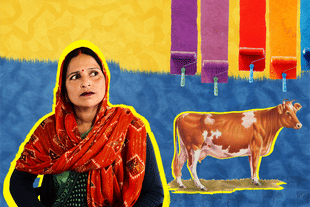
Nawabgunj:
A factory located in a village in Uttar Pradesh's Unnao district is manufacturing wall paint and putty using cow dung. Makers say the initiative, which is barely four months old, is heading towards being profitable.
The factory is associated with a gaushala (cow shelter) that was set up in 2021. It is home to over 500 cattle.
Mithlesh Singh and Jyoti Shukla — the main team leading this initiative, received a mixed response from their close friends and neighbours when they first pitched the idea. Since the paint factory would require an investment of around Rs 20 lakh, they doubted their ability to repay the loan.
Up until now, the gaushala was threatened by economic difficulties. Thanks to the paint factory set up in January 2023, the gaushala now receives a monthly income of Rs 1,80,000 just from the cow dung cakes it sells, they say.
“This is more than what an employee earns in a MNC in Delhi or Mumbai”, says Sunil Singh, a member of the team that runs the factory.
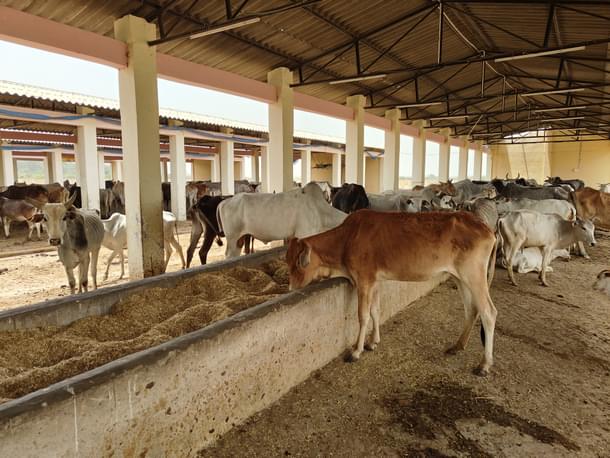
The Concept And How It Began
There is a cultural angle to this, the Block Mission Manager Arvind Kumar Soni says. Cow dung was popularly used in ancient times to sanitise houses. It is still a prevalent practice in the rural parts of the country.
Since there’s cultural similarities to the practice, the team felt that the merging of ideas from urban and rural settings can synchronise well with the idea of producing paint using cow dung cakes.
In Badaun district, there’s a similar setup that already exists. (People from Badaun district come to bigger cities in search of work). When Badaun’s Chief Development Officer (CDO) Rishi Raj got transferred to Unnao, he aspired to set up something similar.
He witnessed how the paint factory led to creation of jobs for the locals. So, the locals' plan was to protect the gaushala as well as to monetize it. Some of the members went for training immediately. Two women, one man and the proprietor received a five-day training from industry experts in Unnao. While this was went on, the team also focussed on building up their website.
They received an amount of nine lakh rupees through the Mahatma Gandhi National Rural Employment Guarantee Act (MGNREGA). All the formalities were completed by the time the team finished their training.
At the block level, around twelve people agreed to the idea of the paint factory. They formed an Association of Persons (AoP) with three people at the helm of affairs: Mithlesh Singh, the chairwoman, Arvind Kumar Soni the deputy and Sulekha ji the secretary.
Rest of the members became a part of the Cluster Level Federation (CLF). They were able to place requests for miscellaneous funds from the CLF, which is funded by the state and the central government. This maintained the transparency of the whole process.
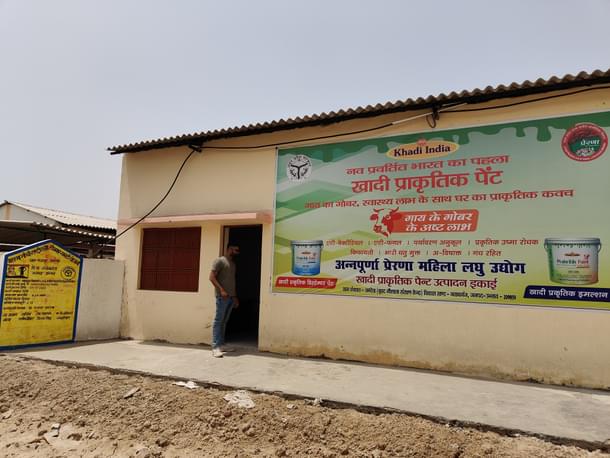
How They Operate
Mithlesh Singh, the chairperson of the paint factory says that the work schedule is dynamic and is normally based on the number of orders they receive. The products are made available in a day or two and the factory is capable of producing up to 250 litres of paint per day.
“Gobar is ground, then it goes on to become Carboxymethyl Cellulose (CMC). Then the gobar is heated using the electric heater, then the water is extracted from the heated paste. We use the leftovers to make wall putty. Since January the manufacturing has begun. One person earns 250 rupees a day. One litre costs us anywhere between 60 and 70 rupees to manufacture”, she adds.
How it’s done: In the pre-mixture slot, gobar is mixed with water in the same proportions. This mixture flows through the mud pump to the triple disk refiner. The thickness of the paste can be adjusted with inputs to the refiner. It goes to the bleaching tank then. After it is bleached, the electric heater is used to heat the composition.
Hydrogen Peroxide and Casting Soda is added to the mix. This changes the colour of the gobar. They let it sit for a day. After this, they sieve it to receive a product called CMC (Carboxymethyl Cellulose). The CMC goes into a hydraulic mixture where chemicals are added to produce the paint. For now, the team packs the paint physically.
Situated right next to the Kanpur-Lucknow highway, the gobar paint factory welcomes you with a hoarding on the wall titled ‘Khadi Prakritik Paint’ — an initiative supported by Khadi India, Ministry of Micro, Small and Medium Enterprises and the Government of Uttar Pradesh.
The project in Unnao is currently being financed by the Bank of India and is assisted under the Prime Minister’s Employment Generation Program (PMEGP). The Village Industrial Board of Unnao supports the venture too.
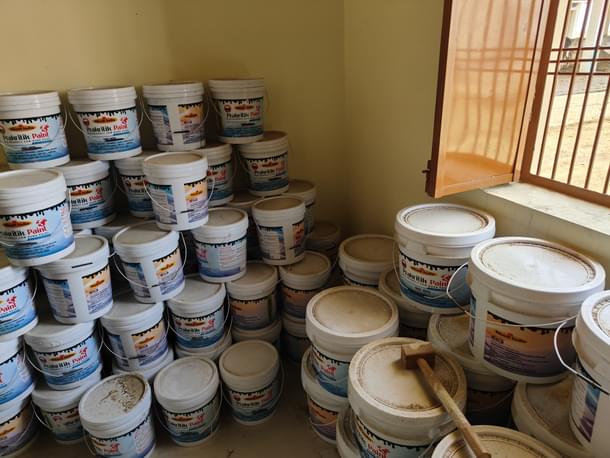
The Economics
Sunil Singh, a member of the team, claims that they conducted a market survey. They targeted the local bodies first, which includes Primary Health Centres (PHCs), jail, and the panchayat offices. These local bodies started using the paint initially, which encouraged the manufacturers to produce more.
Then they targeted the nearest local markets and distributed free samples for consumers’ consumption. Feedback was sought from the consumers who tried the paint at their own establishments — their homes and factories alike. The response was positive and the team started receiving more orders. Now, they have started their operations online. Flipkart and Amazon have enlisted them.
“We encourage online payments from our customers for all the products we sell. There’s no physical cash flow in the entire process. So the transparency is ensured in that sense. We also have a customer care number where people can call in and place their orders. If someone wants to pay cash, we maintain a ledger with all the records which gets reviewed on a monthly basis”, Sunil tells Swarajya.
The gaushala receives two rupees per kilo of the gobar they use to manufacture the paint and other products. Inspired by this, four more units have been started in Pratapgarh, Prayagraj, Amethi and Varanasi, Sunil claims.
Other gaushalas inspired by them, are aspiring to become economically independent. The paint factory, because of the gaushala, attracts frequent visits from local political leaders, including the MLAs and ministers of the state government in Uttar Pradesh. This level of attention ensures that the cattle are taken care of.
The economics of this whole establishment is simply fascinating. On an average, the factory uses 3,000 kilograms of cow dung everyday. They pay two rupees per kilo, allowing an income of Rs 6,000 a day to the gaushala. This means that the gaushala earns Rs 1,80,000 a month.
“This is more than what an employee in a MNC earns. We sell the paint at Rs 120-140 in the market. We sell it to the government at Rs 80-85. The manufacturing cost is around Rs 70 per litre, approximately.
Should we scale up, perhaps the margins will increase significantly. 500 litres can be manufactured in three hours’ time”, Sunil adds, with a smile on his face.
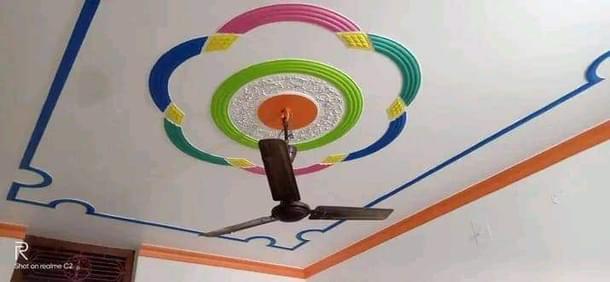
The Response
Jyoti Shukla, who was earlier mentioned in this article, is an important member of the team since she manages the workforce and understands the mechanism of each of the machines. She says that the process has not been entirely easy either.
“In the beginning, my husband and well-wishers were sceptical about the loans we were planning to take from the bank. Whether we’ll be able to repay the loan was a big concern for the people of my village. But I reassured the owners that this initiative would be economically viable for us and we’ll be able to repay the loan. I use the paint in my own house. Local temples use it and the women from several villages purchase the paint”, Jyoti says.
When asked about the distinct features of the paint they produce, Jyoti says that their “paint shines better than the ones in the market”. They claim that the paint does not leave a residual mark on your hand if you were to rub the walls. It does not easily peel off, either, they claim.
The management team, at the moment, is dedicated to focusing on one thing — repaying the loan and then focus on raking in profits from the enterprise.
Anurag Trivedi, founder of Rit Rural Foundation, says that there is more to what meets the eye. He says, "what you see here is aiming towards providing greater sustainable solutions. While the economic prospects of the gaushala and rural economy is definitely a plus, there's also an awakening among the villagers here about the necessity to use greener solutions. For instance, the consumers are now aware of the paint's anti-fungal properties. This has instilled confidence in both the product, and the producers."
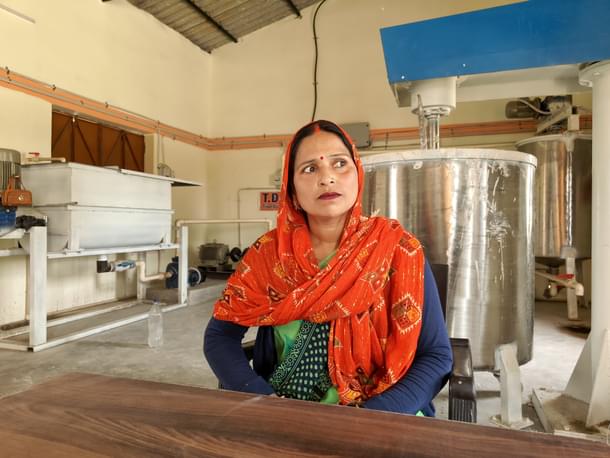
What’s Next
The product claims to have eight benefits: "anti-bacterial, anti-fungal, eco-friendly, natural thermal insulator, cost effective, non-toxic, free from heavy metal and odourless", the display reads.
Arvind Kumar Soni says that the team uses WhatsApp for product promotions. Some people from the government are also a part of these groups. Positive reviews from Amazon and Flipkart spreads the word further and increases the product visibility further, he says.
Making an appeal with folded hands, Soni requests the government to push the product further. “If the paint is used for all the government buildings, entrepreneurs like us will benefit a lot”, he adds.”
BJP leaders like Chief Minister Yogi Adityanath have supported such initiatives in the past. “The cow is the foundation of the Indian economy”, he has been quoted as saying. About a year ago, in January 2022, the Niti Aayog took cognisance of the importance of the cow economy and promised to roll out a roadmap for ‘gaushala economy’ and enable the commercial use of cow dung and cow urine.
Several international and national institutions such as the International Labour Organisation and several Indian Institutes of Management have been studying the various uses and potentials of boosting the cow-based economy.
The progress is not limited to the BJP-ruled states alone. Even in states like Chhattisgarh, similar initiatives are being encouraged by the state governments.
Sharan Setty (Sharan K A) is an Associate Editor at Swarajya. He tweets at @sharansetty2.





